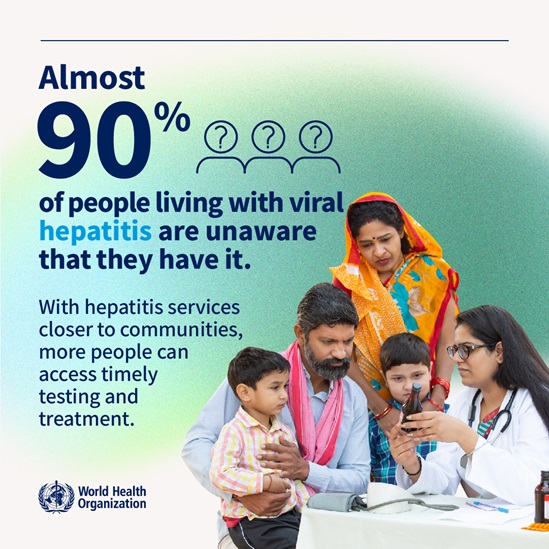Hepatitis
Hepatitis is an inflammation of the liver that is caused by a
variety of infectious viruses and noninfectious
agents leading to a range of health problems, some of which can be fatal. There
are five main strains of the hepatitis virus, referred to as types A, B, C, D
and E. While they all cause liver disease, they differ in important ways
including modes of transmission, severity of the illness, geographical
distribution and prevention methods. In particular, types B and C lead to
chronic disease in hundreds of millions of people and together are the most
common cause of liver cirrhosis, liver cancer and viral hepatitis-related
deaths. An estimated 354 million people worldwide live with hepatitis B or C,
and for most, testing and treatment remain beyond reach.
Some types of hepatitis are preventable through vaccination. A
WHO study found that an estimated 4.5 million premature deaths could be prevented
in low- and middle-income countries by 2030 through vaccination, diagnostic
tests, medicines and education campaigns. WHO’s global hepatitis strategy,
endorsed by all WHO Member States, aims to reduce new hepatitis infections by
90% and deaths by 65% between 2016 and 2030.
Many people with hepatitis A, B, C, D or E exhibit only mild symptoms or no symptoms at all. Each form of the virus, however, can cause more severe symptoms. Symptoms of hepatitis A, B and C may include fever, malaise, loss of appetite, diarrhoea, nausea, abdominal discomfort, dark-coloured urine and jaundice (a yellowing of the skin and whites of the eyes). In some cases, the virus can also cause a chronic liver infection that can later develop into cirrhosis (a scarring of the liver) or liver cancer. These patients are at risk of death.
Hepatitis D (HDV) is only found in people already infected with hepatitis B (HBV); however, the dual infection of HBV and HDV can cause a more serious infection and poorer health outcomes, including accelerated progression to cirrhosis. Development of chronic hepatitis D is rare.
Hepatitis E (HEV) begins with mild fever, reduced appetite, nausea and vomiting lasting for a few days. Some persons may also have abdominal pain, itching (without skin lesions), skin rash or joint pain. They may also exhibit jaundice, with dark urine and pale stools, and a slightly enlarged, tender liver (hepatomegaly), or occasionally acute liver failure.
Safe and effective vaccines are available to prevent hepatitis B virus (HBV). This vaccine also prevents the development of hepatitis D virus (HDV) and given at birth strongly reduces transmission risk from mother to child. Chronic hepatitis B infection can be treated with antiviral agents. Treatment can slow the progression of cirrhosis, reduce incidence of liver cancer and improve long term survival. Only a proportion of people with chronic hepatitis B infection will require treatment. A vaccine also exists to prevent infections of hepatitis E (HEV), although it is not currently widely available. There are no specific treatments for HBV and HEV and hospitalization is not usually required. It is advised to avoid unnecessary medications due to the negative effect on liver function caused by these infections.
Hepatitis C (HCV) can cause both acute and chronic infection. Some people recover on their own, while others develop a life-threatening infection or further complications, including cirrhosis or cancer. There is no vaccine for hepatitis C. Antiviral medicines can cure more than 95% of persons with hepatitis C infection, thereby reducing the risk of death from cirrhosis and liver cancer, but access to diagnosis and treatment remains low.
Hepatitis A virus (HAV) is most common is low- and middle-income countries due to reduced access to clean and reliable water sources and the increased risk of contaminated food. A safe and effective vaccine is available to prevent hepatitis A. Most HAV infections are mild, with the majority of people recovering fully and developing immunity to further infection. However, these infections can also rarely be severe and life threatening due to the risk of liver failure.








